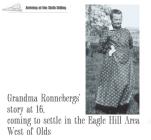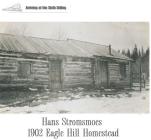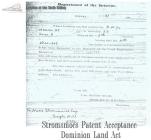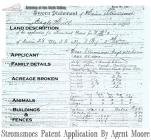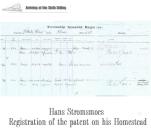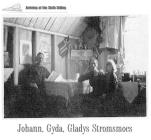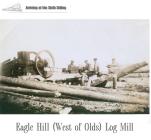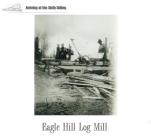2
According to Minnie Kjorsvik's family history: unpublished family document.Grandmas Ronneberg comes to Olds:
Excerpts:
" In the winter of 1902, 5 families from Newfolden Marshall Co. (Minn) got " Canada Fever" and on June 7th with families, household goods, machinery, cows, horses, pigs, chickens, some groceries, clothes, meat, potatoes, and wheatlets boarded the train for the North-West Territories or what became Alberta in1905….
Most of the men with the cars of settlers effects left Thief River falls, our nearest town, a day before the mothers and children. Mr. Ole Johnsrud was left with the women….
Us youngsters ranged between the ages of 16 down to infants in arms. I was the oldest, a girl of 16 years. …Mother had 5 children. Johndruds 3, Stromsmoes 6, Nordhus 3, and the Moes 3 little girls….
…Singing was the entertainment on the trip….
…My dad brought the two oldest boys in the cattle car. Dad had two cars of settlers effects the other four families one each…
When we landed in Winnipeg, my dad and the two boys met us at the station with two big syrup pails of milk which we took with us on the " Immigrant Coach" for the kids.
" We landed in Olds in a blinding snowstorm on June 12th with no place to go but the station…. There was no hotel room to accommodate such a tribe but the Dominion government had seen to that. There was a big brown tent like a circus tent set up back of the stockyards. In the tent had a small cook stove in one corner, some split wood, a long picnic table down the center of the floor or room, or should I say tent…
So away we went thro' mud, snow and slush, dragging kids, boxes, suitcases, a few blankets and pillows and pails, everyone tired, dirty, bedraggled and hungry.
… Food was found , with no bedding it was a cold damp, muddy night….
" The men with cars came the next afternoon and then we got our straw ticks which they brought, so we slept better after that. It rained for a week and we had to stay in the tent, but soon the weather cleared, we loaded up and started for Harmatten where we knew some people. Mr. Moe and family with some of his stuff on his wagon, Alfred Johnsrud and his second oldest sister Charlotte (Later Mrs. Ike Lee) with their little team of mules, Carl Stromsmoe with Louis Gulseth and Fina on his load, and I drove Dad's big team Fanny and Chief.
Mr. Nordhus stayed on in the tent with the women and remaining children. The men and the big boys started out to get the cattle and sheep which were supposed to be herded west of town. However, they were not to be found, so they walked back to town, and we who were on the wagonloads pulled out.
We went west but did not know where to go for the country was new to us…. The Moes were soon out of sight as he had a lighter load… We followed the trails thro' mud and slush and got stuck several times. We drove till dark, when we set up a small tent in my load. We turned loose the horses and calves which I had on my wagon and some were on the other loads too. Our supper was cold meat, bread, butter and black coffee. Next morning we found we were camped in the old Morphy farm. After eating breakfast, hunting the horses and calves, off we went, landing on the quarter section where the Harmattan Hall stands now.
We set up our tent and fooled around. Moes family were settled in our friends house so we camped again in the tent. Next evening, the men and big boys with the cows and sheep arrived, having walked all the way since the morning before when they had located the cattle. ….
Next day, the men tore down a new big log barn and hauled the logs up on top of a high spot and built it up with spruce boughs. They put hay on top of a pole roof and made bunks around in the 3 corners. They then made a long table down the center and put the small 4-holed cook stove which Dad had brought in the 4th corner….
Minnie, Charlotte, Alice and I had nothing but spruce boughs for a mattress. We 4 slept on them for a whole month of rains drenching our beds nearly every night. While the women and girls and my dad milked the cows, I made a big iron kettle full of porridge morning and night. Our stove was so small, they could not make enough bread to keep us going… Nordhus brought some boards and a tent which he built up for his own family. My uncle Sam (Garborg), having arrived to try his luck at " homesteading" was the last of our bunch to come. We were 29 in the big camp, 5 in Nordhus's tent and 5 Moe's in the farms house, 39 in all. After a month of rain, we broke up camp.
3
The Moes were part of the Norwegian group that came to the Eagle Hill area ten miles west of Olds.1902
Olds NWT Canada
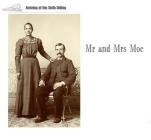
4
Hans Stromsmoes and his family arrived in 1902 and settled in the Eagle Hill area.1902
Olds NWT Canada
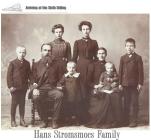
5
According to Minnie Kjorsvik's family history: unpublished family document.Grandmas Ronneberg comes to Olds: Excerpts: part 2
"We had to come across the river by boat down below Howard Yewell's or Wiper's on the south side of the Little Red Deer River. Dad came across with his big team, Fanny and Chief and the river was so high that all we saw was the heads of the horses. We all built up a little shack, each on his own homestead. They had filed on them in Feb. when the men had been here to see where to locate. It was lots of fun for us youngsters but not so easy for our parents. There was so much to be done before winter set in: houses, barns, pens to be built, hay to be put up for winter and fodder for stock.
…
We youngsters put in a lot of our time hunting for cows, horses, calves and sheep. Dad bought us an old pony so at least one of us was always out hunting for something or going over to Harmattan for groceries or the mail….
There were two families living on this side of the river: Tom … and Bob Howard…
They started up a little store and helped us get a post office which was called Eagle Hill …
Mr. Moe settled on what we call the "Dave Mowery" farm. Johnsrud settled at Harmatten but Dad and Stromsmoes settled on what is now Pinkie Remmies place and Melvyn's old place. We churned our cream, raised chickens and hauled our butter and eggs to town for groceries and a few boards, windows and nails. It was lots of fun. We found the winters here so much better than where we came from in northern Minnesota so we were quite content."
7
Hans' application for his quarter section. The survey was not yet registered in Ottawa.1902
Olds NWT Canada
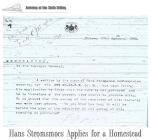
12
JOHAN AND GYDA STROMSMOEJohn (Johan) J. Stromsmoe was born in Bardu, Norway on March 5, 1871. He was raised and educated in Bardu, and became a forestry supervisor as well as being the owner of one of the largest farms there.
He met Gyda Forseth, also of Bardu, and they were married on July 10, 1897. Gyda bore Johan four children before they moved to Canada, the oldest being Aslaug, then Anfrid, Gudrun and Jarand.
John had wanted to go to Canada and so in the summer of 1906 he and his family sailed across the Atlantic Ocean. The ship docked in Halifax, Nova Scotia on August the 9th, so began their trek by train across Canada to Olds, Alberta. They stayed a short time with John's brother, Hans, and his wife, Berit in Eagle Hill and spent the winter months with Gisle and Ingeborg Steine who lived on the farm next to Hans. They were also related.
The following summer their house was built on the SE1/4 4-34-3-W5 in the district of Ennerdale, just two miles from Hans. The homestead was previously owned by their other brother, Ingebrikt Haugen. His wife and family would not come to Canada, so John then took over the homestead.
After settling in their new home, John worked out at harvest on the farm of the Hon. Duncan Marshall. Mr. Marshall was a great help to John and they became good friends.
John also worked out on sawmills for 75 cents a day during the first years in their new land.
Many hardships were experienced by Gyda while John was away working. For example, the nearest store and post office was nearly five miles away and her only means of transportation was walking. Twice a week she would make the trip for supplies and carried them along a rugged trail through the bush to her home. She also had to cut down trees and carry them home where she chopped them up for firewood. She and the children also helped to clear the land so John could plant his first crops. He would then harvest it and take the grain all the way to Didsbury to have it ground into flour and return the same night.
Hardships were numerous for the early settlers as they experienced prairie fires, wind storms and loss of livestock due to sickness and accidents. Food staples were not always plentiful for them. For example, supper would consist mostly of potatoes and dried bread dipped in black coffee. At times they were fortunate enough to have a meal of rabbit. School lunches for the children would often be sandwiches smeared with lard or sour cream. Syrup between the bread would be a delicacy. A real treat for them were the peanuts and peppermints which John would bring home from a visit to town. which was 16 miles away? Clothing for the family would be made from flour sacks, sewn by hand by Gyda who sat up late at nights making them. She also done a lot of knitting and hooking of rugs.
The first of seven children born to them in Canada was Ethel, then came Magna (Karen), Harold, Hanna, Freitjof, Gladys and baby John who died when only a few hours old. With ten children to support, John and Gyda worked very hard to provide for them.
The Stromsmoe's yard became a very busy place at times as the trails from the north would pass close by their home with people going south to the Eagle Hill store. The travelers would stop and talk, mostly of the news of the day, and Gyda would serve them coffee.
It was John and Mr. Gathercole, who had the farm next to him to the north, who were among the first to open up the roads north and east of their farms. Can you imagine what they were like in thos days? Not the well-graveled and paved roads that exist today.
The Ennerdale school was instigated by my grandfather, Johan and Mr. Gathercole, and was opened in 1912. Seven pupils attended the first year, my mother Aslaug, her sister and brother, Anfrid and Jarand, Doris, Evelyn and Bob Gathercole and Sylvia Dokken. Miss Merle Miller (later to become Merle Willsie) was their first school teacher. Scool days were happy times for the children. The teacher would take her pupils and go out west across the Big Red Deer River to pick blueberries and cranberries. There was no bridge or ferry in those days, so they had to forge the river with a team of horses and wagon. Sometimes the water would reach the wagon-box. They would set up a camp for a few days and at times the little black bears would come around and try to steal the berries they had picked. The pupils would be proud bringing the berries to their parents.
On Sundays in the summers, the children would enjoy ball games which were held on the flats by the Little Red Deer River just east of the Stromsmoe farm. In the winters, they would play hockey games on the backwater of the river. The children would make their own fun which they took great delight in.
The first church services the settlers had was held in the Eagle Hill school by Rev. A.O. Kolden and were spoken in Norwegian as the settlers in the district were from Norway and hadn't learned to speak English yet.
In the mid years, John supervised bridge construction which took him all over Alberta. While working in Vermilion, he took very ill with typhoid fever and spent several months in the hospital there. He also helped to construct and supervise both the Ennerdale Bridge and the Eagle Hill Bridge (which is still in use today I think, the year 2003). Around 1914, he was active as a trustee of the Ennerdale School Board and held that position for a few years. He was an agent for the Sarsee First Nations west of Calgary for many years. John liked working with them very much. Chief Eno Hunter and some of the natives would pitch their tents on John's farm to conduct business for a few days.
In the later years, John was game warden and weed inspector for his distict and further. His life was very active up until his death on August 24, 1950.
Gyda passed away on March 22, 1960, Baby John 1918, Freitjof was killed with his father in a car accident, Gudrun passed away in September 1962, Anfrid, April 1970, Gladys, April 1971, Magna, March 1973, Jarand (Johnnie),September 1978, Ethel, November 1984, Aslaug, July 1990, Hanna, January 1992, Harold, killed in a car accident, September 1993.
John and Gyda had 11 children, nine grandchildren, and several great grandchildren. Through this family history they will always be remembered.
Written by their granddaughter,
Sonja (Kaasen) Scott
